
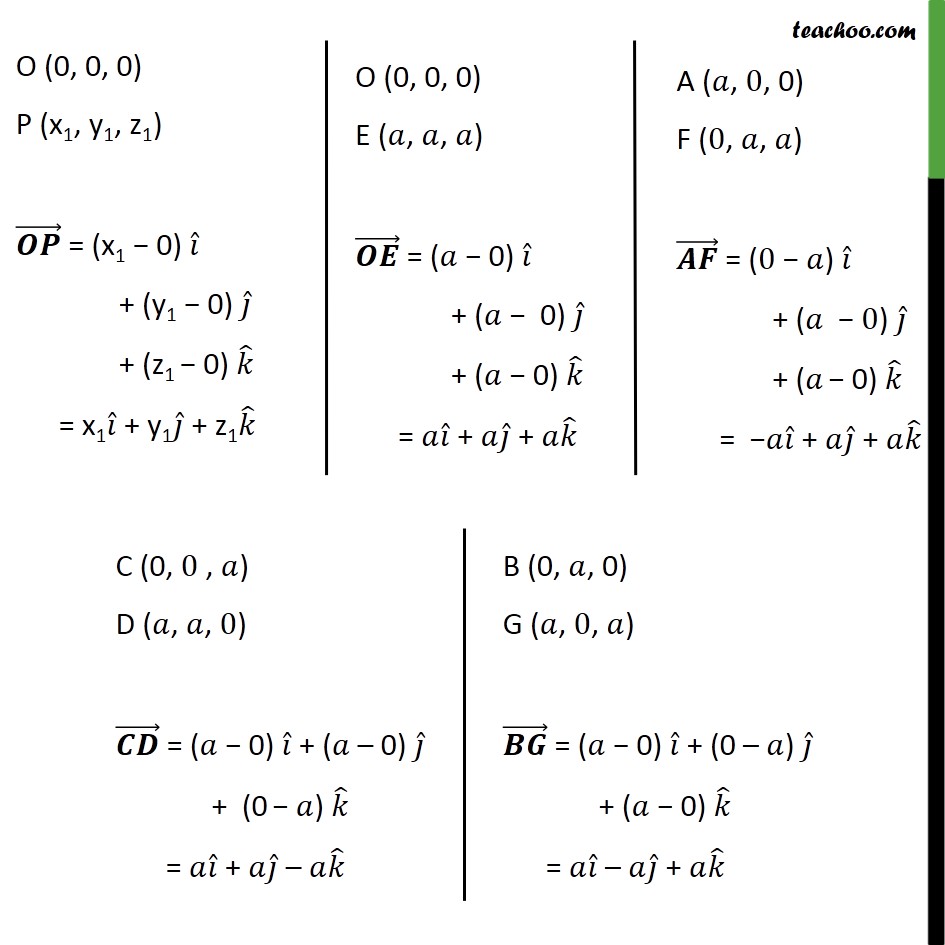
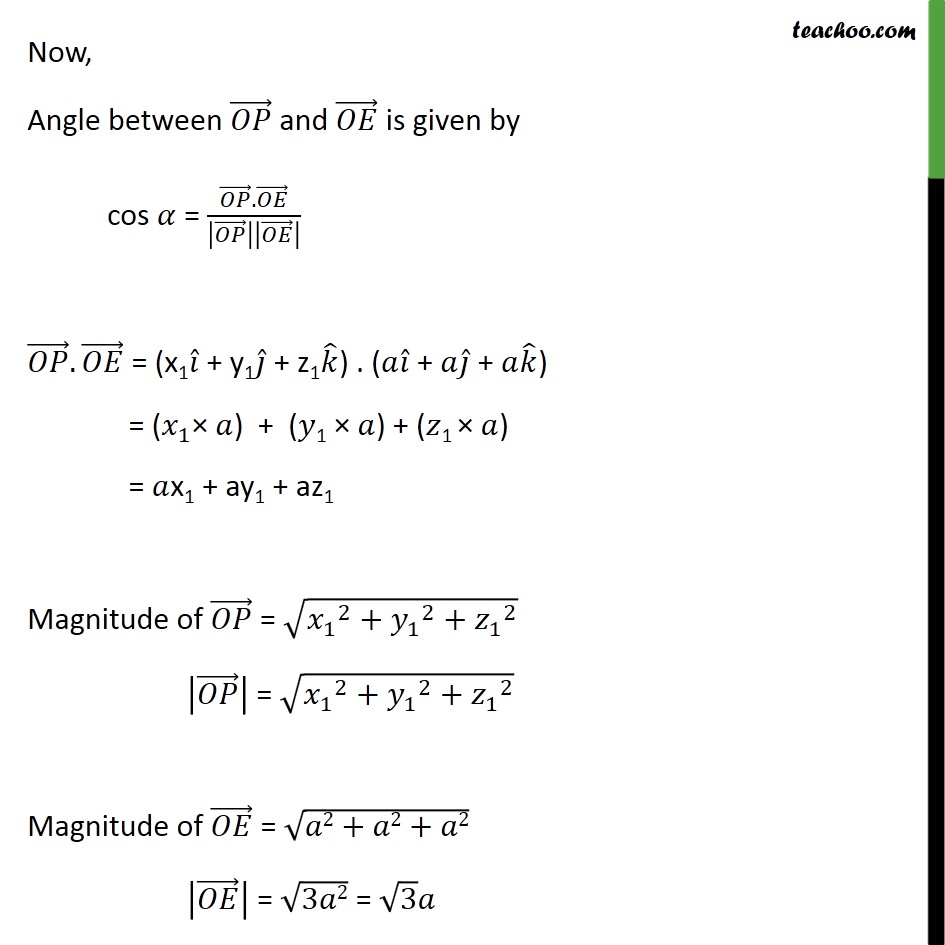
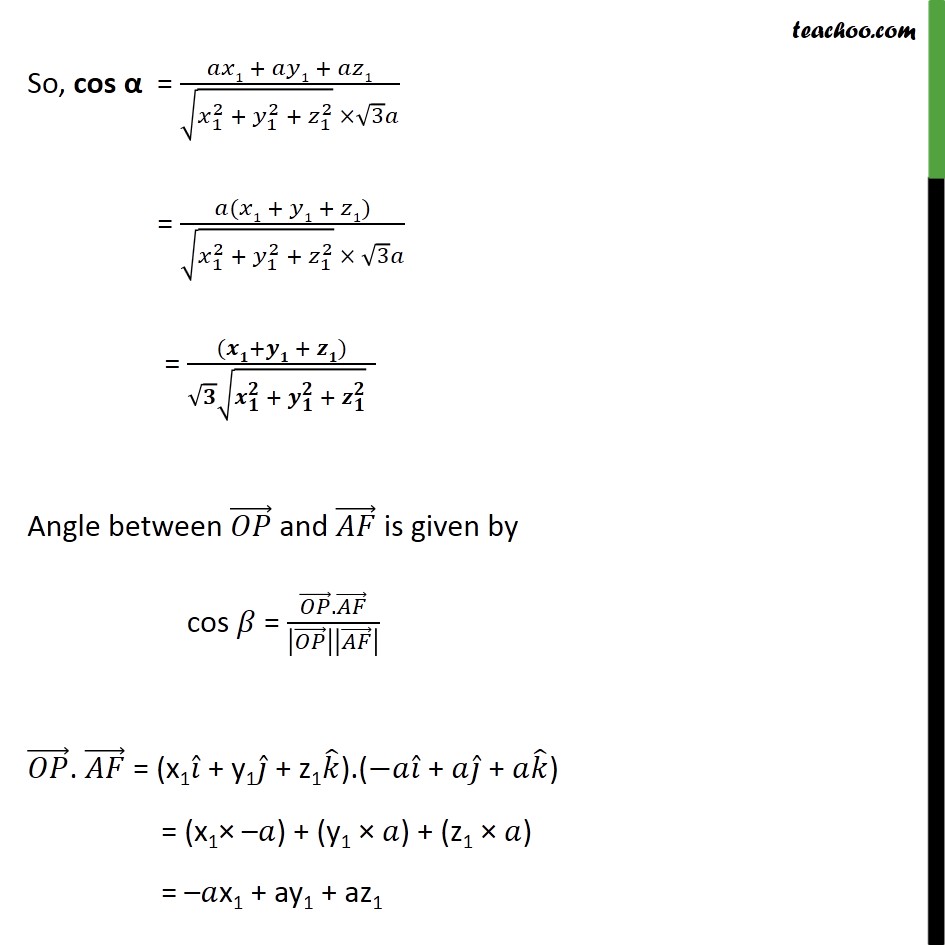
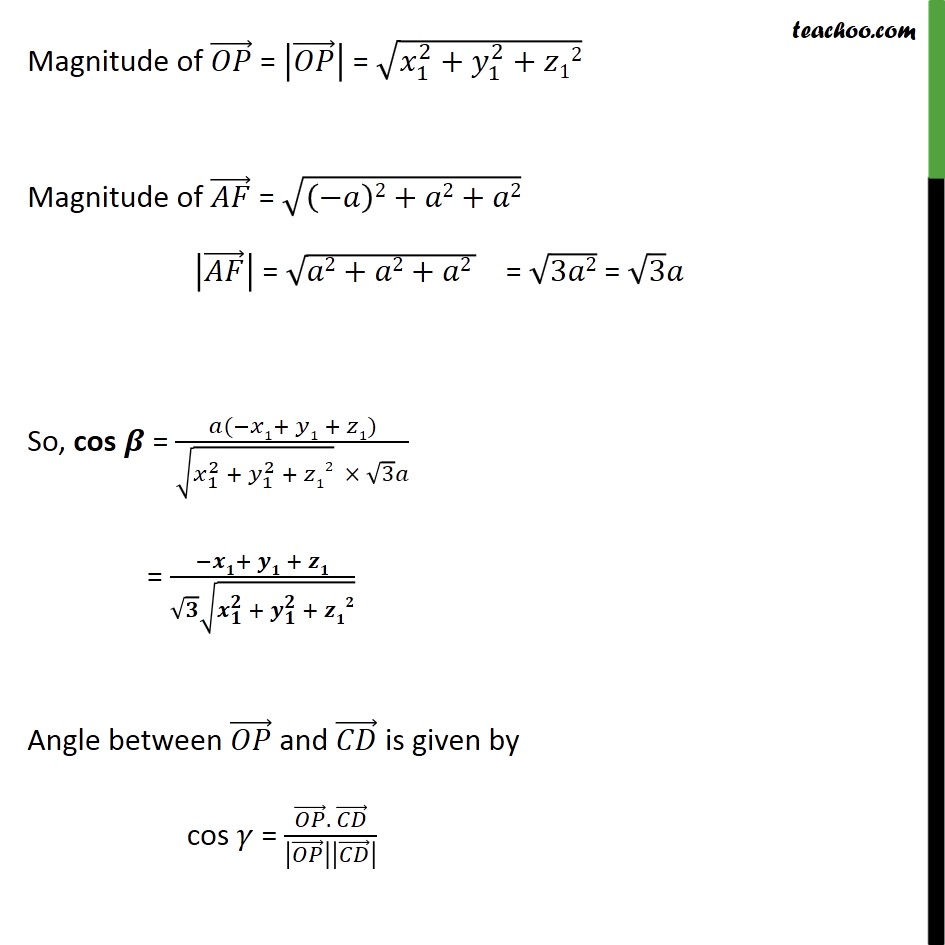
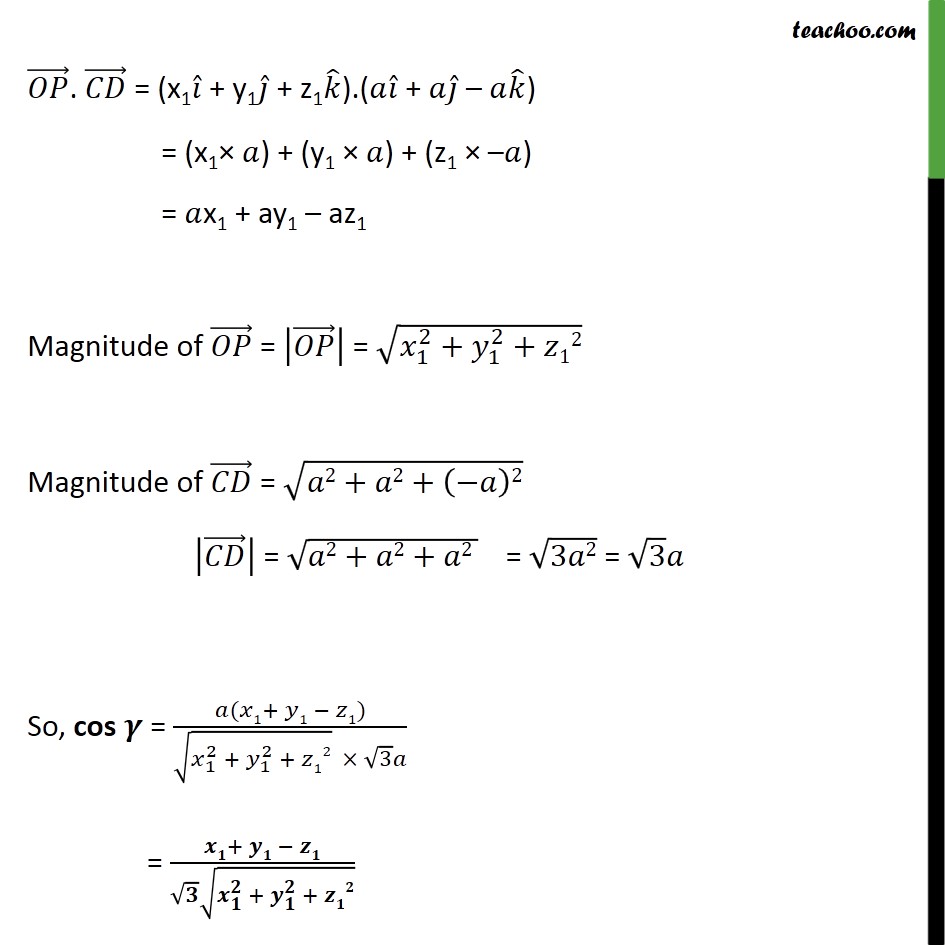
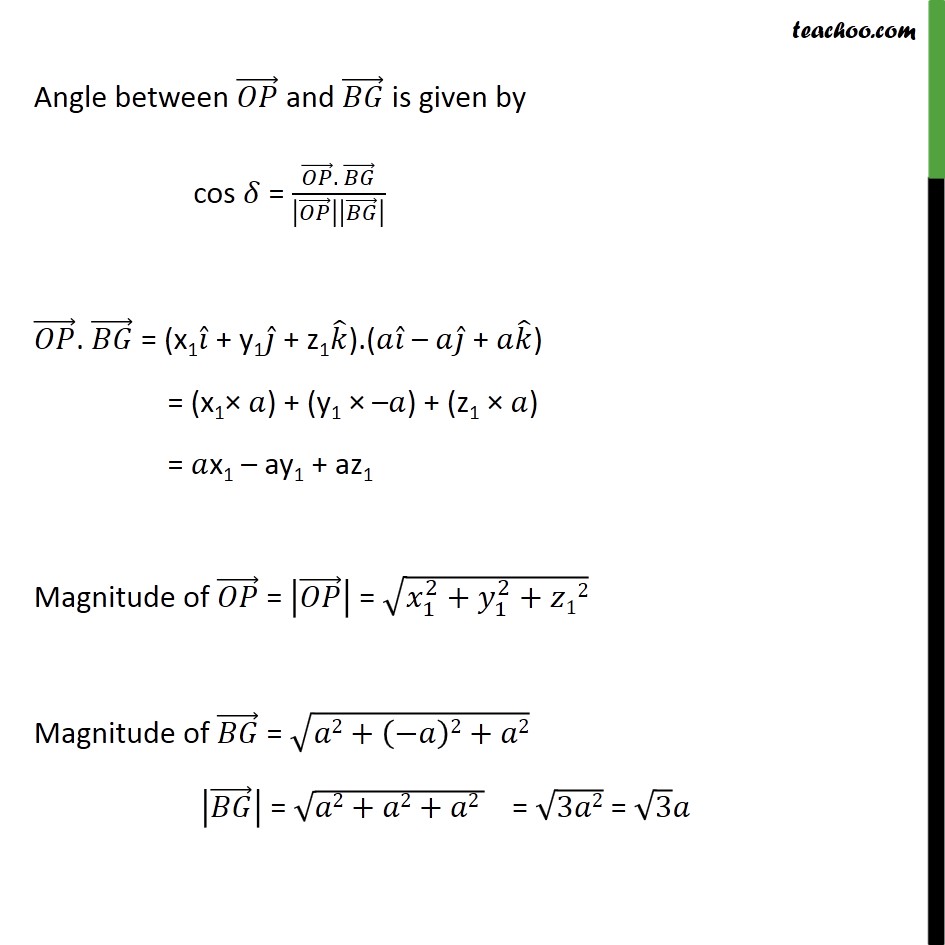
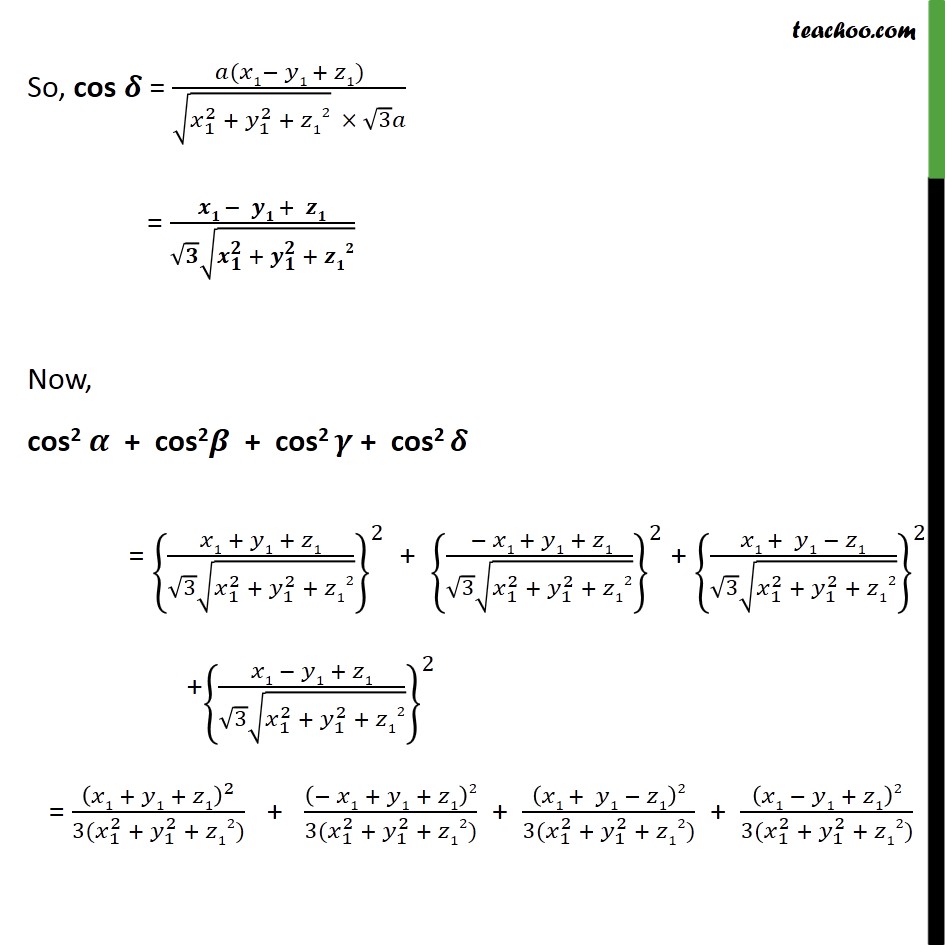
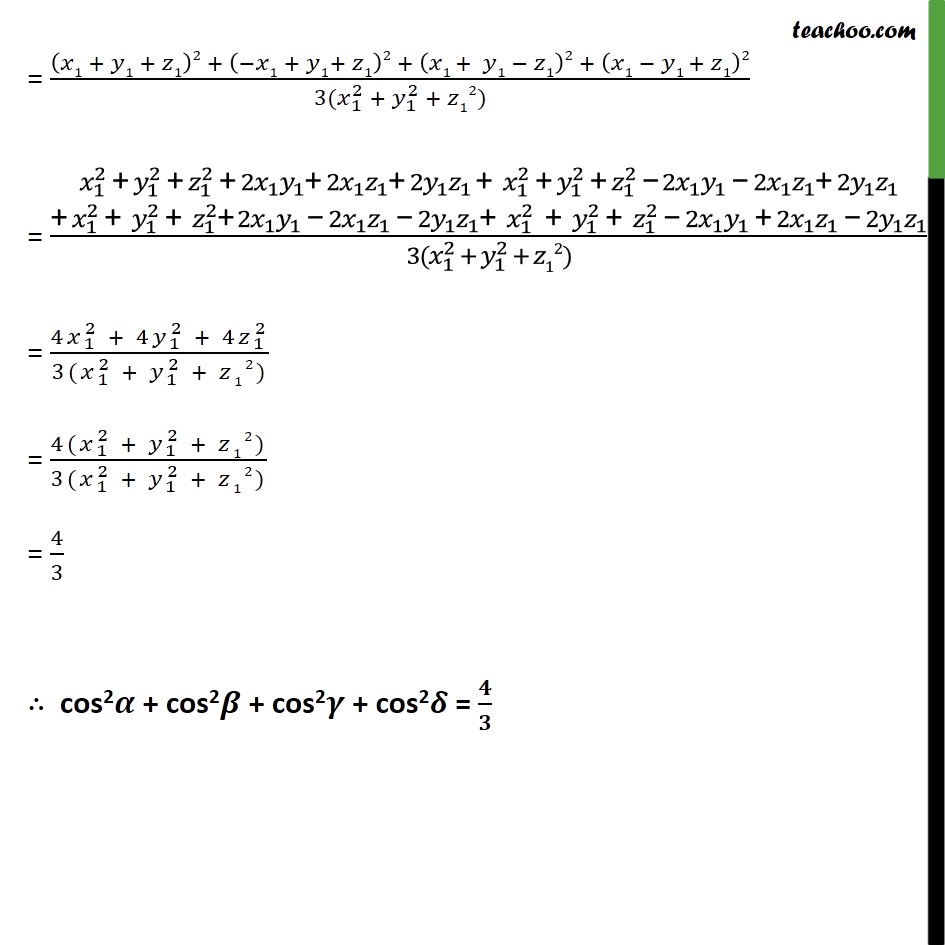
Examples
Last updated at Dec. 16, 2024 by Teachoo









Transcript
Question 16 A line makes angles 𝛼, 𝛽 , 𝛾 and 𝛿 with the diagonals of a cube, prove that cos2 𝛼 + cos2𝛽 + cos2 𝛼 + cos2𝛾 = 43 Let the side of a cube be ‘a’ Vertices of the cube are ABCDEFOG as shown. Consider a line OP , P having the coordinate (x1, y1, z1) Let OP make angles 𝛼, 𝛽 , 𝛾 and 𝛿 with diagonals OE, AF, CD and BG respectively. Finding lines OE, AF, CD and BG first. Now, Angle between 𝑂𝑃 and 𝑂𝐸 is given by cos 𝛼 = 𝑂𝑃. 𝑂𝐸 𝑂𝑃 𝑂𝐸 𝑂𝑃. 𝑂𝐸 = (x1 𝑖 + y1 𝑗 + z1 𝑘) . (𝑎 𝑖 + 𝑎 𝑗 + 𝑎 𝑘) = ( 𝑥1× 𝑎) + (𝑦1 × 𝑎) + (𝑧1 × 𝑎) = 𝑎x1 + ay1 + az1 Magnitude of 𝑂𝑃 = 𝑥12+ 𝑦12+ 𝑧12 𝑂𝑃 = 𝑥12+ 𝑦12+ 𝑧12 Magnitude of 𝑂𝐸 = 𝑎2+𝑎2+𝑎2 𝑂𝐸 = 3𝑎2 = 3𝑎 So, cos α = 𝑎𝑥1 + 𝑎𝑦1 + 𝑎𝑧1 𝑥12 + 𝑦12 + 𝑧12 × 3𝑎 = 𝑎(𝑥1 + 𝑦1 + 𝑧1) 𝑥12 + 𝑦12 + 𝑧12 × 3𝑎 = (𝒙𝟏+𝒚𝟏 + 𝒛𝟏) 𝟑 𝒙𝟏𝟐 + 𝒚𝟏𝟐 + 𝒛𝟏𝟐 Angle between 𝑂𝑃 and 𝐴𝐹 is given by cos 𝛽 = 𝑂𝑃. 𝐴𝐹 𝑂𝑃 𝐴𝐹 𝑂𝑃. 𝐴𝐹 = (x1 𝑖 + y1 𝑗 + z1 𝑘).(−𝑎 𝑖 + 𝑎 𝑗 + 𝑎 𝑘) = (x1× –𝑎) + (y1 × 𝑎) + (z1 × 𝑎) = –𝑎x1 + ay1 + az1 Magnitude of 𝑂𝑃 = 𝑂𝑃 = 𝑥12+ 𝑦12+𝑧12 Magnitude of 𝐴𝐹 = −𝑎2+𝑎2+𝑎2 𝐴𝐹 = 𝑎2+𝑎2+𝑎2 = 3𝑎2 = 3𝑎 So, cos 𝜷 = 𝑎(−𝑥1+ 𝑦1 + 𝑧1) 𝑥12 + 𝑦12 + 𝑧12 × 3𝑎 = −𝒙𝟏+ 𝒚𝟏 + 𝒛𝟏 𝟑 𝒙𝟏𝟐 + 𝒚𝟏𝟐 + 𝒛𝟏𝟐 Angle between 𝑂𝑃 and 𝐶𝐷 is given by cos 𝛾 = 𝑂𝑃. 𝐶𝐷 𝑂𝑃 𝐶𝐷 𝑂𝑃. 𝐶𝐷 = (x1 𝑖 + y1 𝑗 + z1 𝑘).(𝑎 𝑖 + 𝑎 𝑗 – 𝑎 𝑘) = (x1× 𝑎) + (y1 × 𝑎) + (z1 × –𝑎) = 𝑎x1 + ay1 – az1 Magnitude of 𝑂𝑃 = 𝑂𝑃 = 𝑥12+ 𝑦12+𝑧12 Magnitude of 𝐶𝐷 = 𝑎2+𝑎2+ −𝑎2 𝐶𝐷 = 𝑎2+𝑎2+𝑎2 = 3𝑎2 = 3𝑎 So, cos 𝜸 = 𝑎(𝑥1+ 𝑦1 − 𝑧1) 𝑥12 + 𝑦12 + 𝑧12 × 3𝑎 = 𝒙𝟏+ 𝒚𝟏 − 𝒛𝟏 𝟑 𝒙𝟏𝟐 + 𝒚𝟏𝟐 + 𝒛𝟏𝟐 Angle between 𝑂𝑃 and 𝐵𝐺 is given by cos 𝛿 = 𝑂𝑃. 𝐵𝐺 𝑂𝑃 𝐵𝐺 𝑂𝑃. 𝐵𝐺 = (x1 𝑖 + y1 𝑗 + z1 𝑘).(𝑎 𝑖 – 𝑎 𝑗 + 𝑎 𝑘) = (x1× 𝑎) + (y1 × –𝑎) + (z1 × 𝑎) = 𝑎x1 – ay1 + az1 Magnitude of 𝑂𝑃 = 𝑂𝑃 = 𝑥12+ 𝑦12+𝑧12 Magnitude of 𝐵𝐺 = 𝑎2+ −𝑎2+𝑎2 𝐵𝐺 = 𝑎2+𝑎2+𝑎2 = 3𝑎2 = 3𝑎 So, cos 𝜹 = 𝑎(𝑥1− 𝑦1 + 𝑧1) 𝑥12 + 𝑦12 + 𝑧12 × 3𝑎 = 𝒙𝟏 − 𝒚𝟏 + 𝒛𝟏 𝟑 𝒙𝟏𝟐 + 𝒚𝟏𝟐 + 𝒛𝟏𝟐 Now, cos2 𝜶 + cos2𝜷 + cos2 𝜸 + cos2 𝜹 = 𝑥1 + 𝑦1 + 𝑧1 3 𝑥12 + 𝑦12 + 𝑧122 + − 𝑥1 + 𝑦1 + 𝑧1 3 𝑥12 + 𝑦12 + 𝑧122 + 𝑥1 + 𝑦1 − 𝑧1 3 𝑥12 + 𝑦12 + 𝑧122 + 𝑥1 − 𝑦1 + 𝑧1 3 𝑥12 + 𝑦12 + 𝑧122 = 𝑥1 + 𝑦1 + 𝑧123( 𝑥12 + 𝑦12 + 𝑧12) + − 𝑥1 + 𝑦1 + 𝑧123( 𝑥12 + 𝑦12 + 𝑧12) + 𝑥1 + 𝑦1 − 𝑧123( 𝑥12 + 𝑦12 + 𝑧12) + 𝑥1 − 𝑦1 + 𝑧123( 𝑥12 + 𝑦12 + 𝑧12) = 𝑥1 + 𝑦1 + 𝑧12 + −𝑥1 + 𝑦1+ 𝑧12 + 𝑥1 + 𝑦1 − 𝑧12 + 𝑥1 − 𝑦1 + 𝑧123( 𝑥12 + 𝑦12 + 𝑧12) = 𝑥12 + 𝑦12 + 𝑧12 + 2 𝑥1 𝑦1+ 2 𝑥1 𝑧1+ 2 𝑦1 𝑧1 + 𝑥12 + 𝑦12 + 𝑧12 − 2 𝑥1 𝑦1 − 2 𝑥1 𝑧1+ 2 𝑦1 𝑧1+ 𝑥12 + 𝑦12 + 𝑧12+ 2 𝑥1 𝑦1 − 2 𝑥1 𝑧1 − 2 𝑦1 𝑧1+ 𝑥12 + 𝑦12 + 𝑧12 − 2 𝑥1 𝑦1 + 2 𝑥1 𝑧1 − 2 𝑦1 𝑧13( 𝑥12 + 𝑦12 + 𝑧12) = 4 𝑥12 + 4 𝑦12 + 4 𝑧123( 𝑥12 + 𝑦12 + 𝑧12) = 4( 𝑥12 + 𝑦12 + 𝑧12)3( 𝑥12 + 𝑦12 + 𝑧12) = 43 ∴ cos2𝜶 + cos2𝜷 + cos2𝜸 + cos2𝜹 = 𝟒𝟑